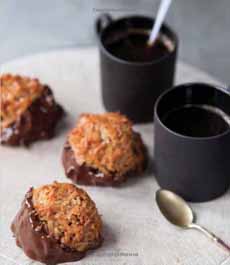PRODUCT: Danny Macaroons For Passover & All Year ‘Round
|
Before there were macarons, the popular French meringue cookie sandwiches, there were macaroons. The chewy, gluten-free* coconut cookies are a delight year-round, but especially appreciated by Passover observers. Made of shredded coconut, sweetened condensed milk, and egg whites—without the flour or leavening that are verboten during this holiday—they happily replace other baked sweets. Dan Cohen of Danny’s Macaroons, author of The Macaroon Bible, is one of the country’s—and probably the world’s—most creative macaroon makers. Beyond his grandmother’s plain and chocolate dipped, he’s brought macaroons into the new age of flavor. His cookies are certified kosher (by United Kosher Supervision), but are not specifically kosher for Passover. Still, those who observe the spirit of the law if not the letter of it, will enjoy every bite. Bonus: Danny Macaroons are not jumbo like some, but a more elegant size: fewer calories! Choices include with or without caramel, chocolate or nuts. Some flavors vary seasonally. The current choices include: Many more flavors are featured in The Macaroon Bible, where Danny presents more than 40 coconut macaroon, almost all of them gluten free. In addition to the classics, consider Amaretto, Cherry-Chocolate, Bailey’s, Bourbon, Chocolate Malted, Guava, Hibiscus, Maple Pecan, Mocha PB&J, Piña Colada, Red Velvet, Raspberry, Rice Pudding, Rocky Road, Spiced Pumpkin, Stout, plus more flavors that have never been seen in a macaroon. Get your macaroons at DannyMacaroons.com. The Macaroon Bible is available at Amazon and other booksellers. “Macaroon” means different things to different people. To some, it’s a big ball of coconut, to others, a delicate, airy meringue. |
|
|
|
Both are delicious and neither is made with grain flour, making them options for gluten-free observers and for the Jewish holiday of Passover. The first macaroons were almond meringue cookies similar to today’s Amaretti di Saronno, with a crisp crust and a soft interior. They were made from egg whites and almond paste. Macaroons traveled to France in 1533 with the pastry chefs of Catherine de Medici, wife of King Henri II. Two Benedictine nuns, Sister Marguerite and Sister Marie-Elisabeth, seeking asylum in the town of Nancy during the French Revolution (1789-1799), paid for their housing by baking and selling the macaroon cookies, and thus became known as the “Macaroon Sisters” (the French word is macaron, pronounced mah-kah-RONE). Italian Jews adopted the cookie because it has no flour or leavening, an agent that raises and lightens a baked good, such as baking powder and baking soda (instead, macaroons are leavened by egg whites). The recipe was introduced to other European Jews and became popular for Passover as well as a year-round sweet. Over time, coconut was added to the ground almonds in Jewish macaroons, and, in certain recipes, completely replaced them. Coconut macaroons are more prevalent in the U.S. and the U.K.—and they’re a lot easier to make and transport than the fragile almond meringues that became the norm in France. Here’s more macaroon history. ________________ *The traditional recipe is made from sweetened shredded coconut, sweetened condensed milk, egg whites, vanilla extract and salt. Different ingredients may be added to create specialty flavors. Not all of these are gluten free. |
||


